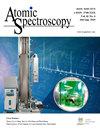In Situ Investigation Of The Valence States Of Iron-Bearing Phases In Chang’E-5 Lunar Soil Using FIB, AES, And TEM-EELS Techniques
IF 2.3
2区 化学
Q1 SPECTROSCOPY
引用次数: 8
Abstract
: Nanophase iron (np-Fe 0 ) is a major product of space weathering and its presence significantly alters the reflectance spectral characteristics of lunar soil. Previous studies have established that the np-Fe 0 particles originate from the reduction of ferrous ions in the plasma, in-situ decomposition of olivine and pyroxene, and disproportionation of ferrous ions in solid ferrosilicates. In this study, sample charging effects were eliminated and in situ nanoscale valence state analysis of iron-bearing phases in Chang’E-5 lunar soil was conducted by combining focused ion beam (FIB) microscopy, Auger electron spectroscopy (AES), and transmission electron microscopy-electron energy loss spectroscopy (TEM-EELS) techniques. The results indicate that the contents and valence states of iron in the np-Fe 0 particles, amorphous matrix, and ferrosilicates differ. The np-Fe 0 particles were found to be composed of pure metallic iron, whereas ferrous and ferric iron ions were present in olivine crystals and the amorphous matrix, respectively. The discovery of both metallic and ferric iron in the amorphous matrix of Chang’E-5 lunar soil offers new insights regarding the disproportionation reaction of Fe 2+ on the lunar surface. This study demonstrates that the combination of FIB, AES, and TEM-EELS is an effective and precise approach for analyzing the valence states of iron-bearing phases in lunar soil, which can be extended to other extraterrestrial samples and other multivalent elements.利用FIB、AES和TEM-EELS技术原位研究嫦娥五号月球土壤中含铁相的价态
纳米相铁(np- fe0)是空间风化的主要产物,它的存在显著改变了月球土壤的反射率光谱特征。先前的研究已经确定,np-Fe 0颗粒来源于等离子体中亚铁离子的还原、橄榄石和辉石的原位分解以及固体硅铁中亚铁离子的歧化。在消除样品电荷效应的基础上,结合聚焦离子束(FIB)显微镜、俄歇电子能谱(AES)和透射电子能谱(TEM-EELS)技术,对嫦娥五号月球土壤中含铁相进行了原位纳米价态分析。结果表明,nfp - fe 0颗粒、非晶基体和硅酸铁中铁的含量和价态不同。发现np- fe0颗粒由纯金属铁组成,而亚铁和三铁离子分别存在于橄榄石晶体和非晶基体中。在“嫦娥五号”月壤非晶态基质中同时发现金属铁和铁离子,为研究月球表面Fe 2+的歧化反应提供了新的思路。研究结果表明,FIB、AES和TEM-EELS相结合是一种有效、精确的月壤含铁相价态分析方法,可推广到其他地外样品和其他多价元素中。
本文章由计算机程序翻译,如有差异,请以英文原文为准。
求助全文
约1分钟内获得全文
求助全文
来源期刊

Atomic Spectroscopy
物理-光谱学
CiteScore
5.30
自引率
14.70%
发文量
42
审稿时长
4.5 months
期刊介绍:
The ATOMIC SPECTROSCOPY is a peer-reviewed international journal started in 1962 by Dr. Walter Slavin and now is published by Atomic Spectroscopy Press Limited (ASPL). It is intended for the rapid publication of both original articles and review articles in the fields of AAS, AFS, ICP-OES, ICP-MS, GD-MS, TIMS, SIMS, AMS, LIBS, XRF and related techniques. Manuscripts dealing with (i) instrumentation & fundamentals, (ii) methodology development & applications, and (iii) standard reference materials (SRMs) development can be submitted for publication.
 求助内容:
求助内容: 应助结果提醒方式:
应助结果提醒方式:


